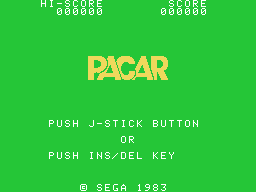Pacar
From Sega Retro
| Pacar | ||||||||||||||||||||||||||||||||||||||||
|---|---|---|---|---|---|---|---|---|---|---|---|---|---|---|---|---|---|---|---|---|---|---|---|---|---|---|---|---|---|---|---|---|---|---|---|---|---|---|---|---|
| System(s): SG-1000 | ||||||||||||||||||||||||||||||||||||||||
| Publisher: Sega Enterprises, Ltd. (JP), John Sands Electronics (AU), Grandstand Leisure (NZ) | ||||||||||||||||||||||||||||||||||||||||
| Developer: Sega Personal Computer Div.[1] | ||||||||||||||||||||||||||||||||||||||||
| Genre: Action[2] | ||||||||||||||||||||||||||||||||||||||||
| Number of players: 1 | ||||||||||||||||||||||||||||||||||||||||
|
This short article is in need of work. You can help Sega Retro by adding to it.
Pacar (パッカー) is an SG-1000 game initially released in 1983. It is essentially a mix between two Namco games; Pac-Man and Rally X.
It is the sequel to Head-On, which was released a year before Puck-Man. However, Pacar is more-so a clone of Puck-Man than a true Head-On sequel.
Contents
Synopsis
| “ |
PACAR, a mischievous car runs through the 3-dimensional routes freely advancing and reversing at fast and low speeds. Try to delete all the DOTS on the screen by avoiding the 2 kinds of enemy cars. When you pass through the special DOTS, PACAR becomes more and more invincible as it increases its power and will be free from damage even when it crashes into the enemy car. Keep up the torrid pace and destroy as many of the enemy cars as possible. |
„ |
— AU SG-1000 box backcover [7] | ||
Gameplay
The player controls "Pacar", a "mischievous" green car through a maze of roads. The objective of the game is to "delete" all of the small red "dots" scattered around the playfield, building up points for a high score. The joystick allows Pacar to move in the proposed direction, assuming it is possible to do so. Like Pac-Man, Pacar does not stop moving unless it hits a wall, however unlike Pac-Man, it is not possible to rotate 180 degrees on the spot - moving in the opposite direction causes Pacar to reverse, and reversing is significantly slower than driving normally. Ideally the player should plan his or her route to avoid reversing altogether.
![]() or
or ![]() allows Pacar to move faster across the board. Driving off the edge of the screen makes Pacar appear at the other side, again similar to Pac-Man.
allows Pacar to move faster across the board. Driving off the edge of the screen makes Pacar appear at the other side, again similar to Pac-Man.
The game has Pacar avoid two types of enemy, also depicted as cars. Blue cars spawn from the garage at the centre of the screen and wander around the play area, only following Pacar if it is close by. Red cars spawn randomly on the road behind Pacar, and are much more aggressive with their tactics. Red cars also differ in that if Pacar speeds up, they will also increase their speed. If either car crashes into Pacar under normal conditions, the player loses a life.
Under certain conditions the game's equivalent of Pac Man's power pellets appear after deleting smaller dots. These give Pacar "temporary invincibility" turning it purple in the process, and act as the only form of attack against oppoents. While purple, the player is free to crash into as many cars as he or she likes, and is granted extra points in the process (starting at 200 and doubling for each successive hit, i.e. 200, 400, 800, 1600, 3200 etc.). It will also slow down red cars. Though there are typically fewer enemies on-screen in Pacar than Pac-Man, the fact that blue cars spawn from the garage instantly after being deleted means it is possible to achieve much higher point combos.
There are only two maps in Pacar, which cycle endlessly until the player dies. The game claims it is "three dimensional" as some roads in map 1 act as bridges over other roads. Once both maps are completed the player proceeds to the next "round", in which more blue cars are added to the playfield (with the exception of round 4, in which the three "normal" blue cars are replaced with one faster blue car. Round 5 will then add a second faster car and so on).
Extra lives are awarded every 10,000 (?) points.
Magazine articles
- Main article: Pacar/Magazine articles.
Screenshots
Physical scans
| Sega Retro Average | ||||||||||||||
|---|---|---|---|---|---|---|---|---|---|---|---|---|---|---|
|
| 55 | |
|---|---|
| Based on 2 reviews | |
| SG-1000, EU |
|---|
|
| SG-1000, NZ |
|---|
|
| SG-1000, TW |
|---|
|
Technical information
ROM dump status
| System | Hash | Size | Build Date | Source | Comments | |||||||||
|---|---|---|---|---|---|---|---|---|---|---|---|---|---|---|
| ? |
|
16kB | Cartridge (EU/JP) | |||||||||||
| ? |
|
40kB | Cartridge (JP) | |||||||||||
| ? |
|
16kB | Cartridge (TW) |
References
- ↑ Pacar SG1000 FR Manual.pdf
- ↑ 2.0 2.1 https://sega.jp/history/hard/sc3000/software.html (Wayback Machine: 2020-09-28 02:34)
- ↑ Game Machine, "1985-07-15" (JP; 1985-07-15), page 9
- ↑ L'Ordinateur_Individuel, "Novembre 1984" (FR; 1984-11-xx), page 94
- ↑ Video Giochi News, "Gennaio 1985" (IT; 198x-xx-xx), page 123
- ↑ File:TTS AU Catalogue 1.pdf, page 2
- ↑ File:Pacar SG-1000 AU Back.jpg
- ↑ Computer Input, "April 1984" (NZ; 1984-xx-xx), page 1
- ↑ L'Ordinateur_Individuel, "Novembre 1984" (FR; 1984-11-xx), page 130
- 1 player games
- JP SG-1000 games
- All JP games
- EU SG-1000 games
- All EU games
- FR SG-1000 games
- All FR games
- IT SG-1000 games
- All IT games
- AU SG-1000 games
- All AU games
- NZ SG-1000 games
- All NZ games
- TW SG-1000 games
- All TW games
- SG-1000 games
- 1983 SG-1000 games
- All 1983 games
- SG-1000 action games
- All action games
- All games
- Stubs
- Old technical information







